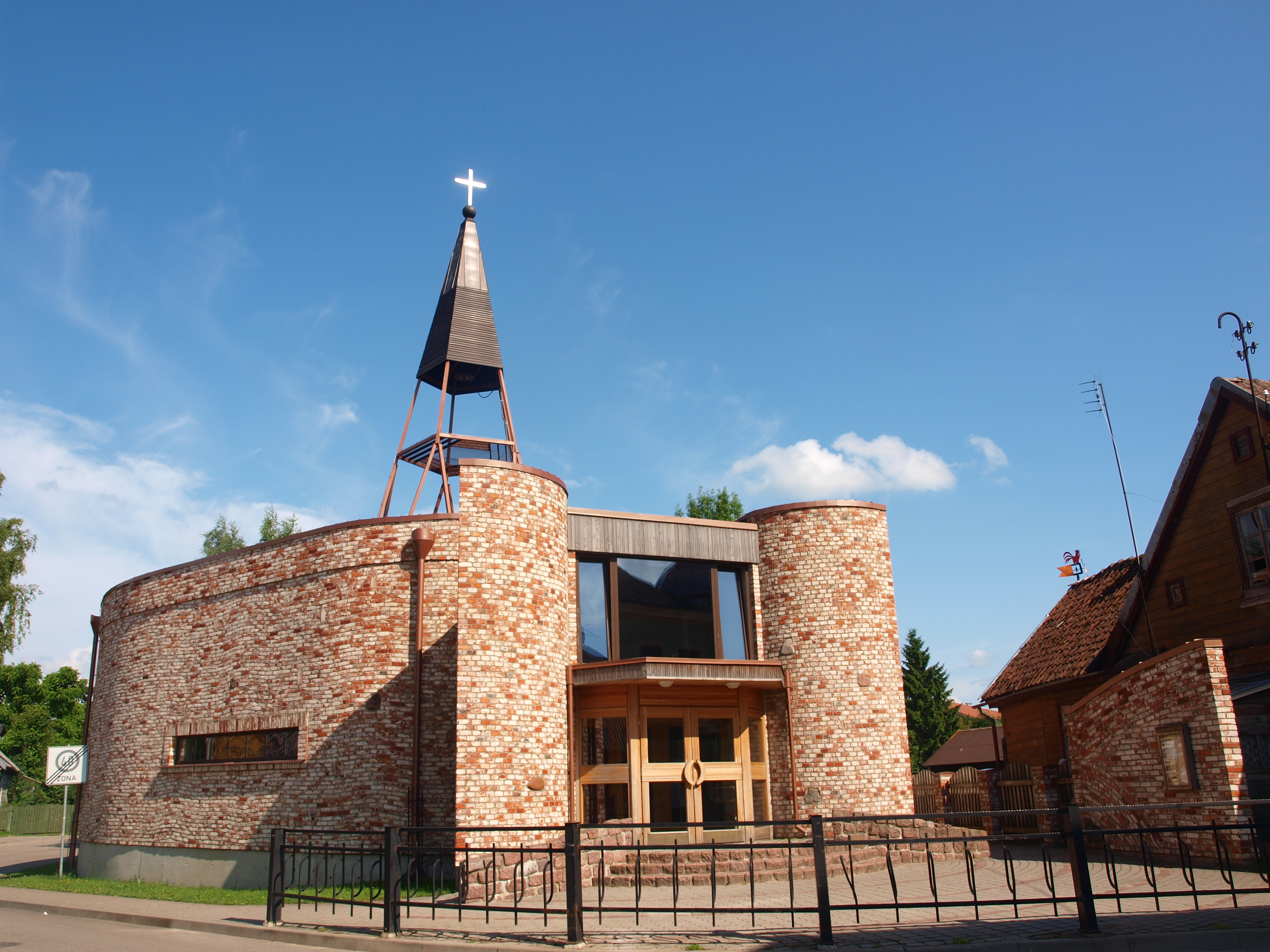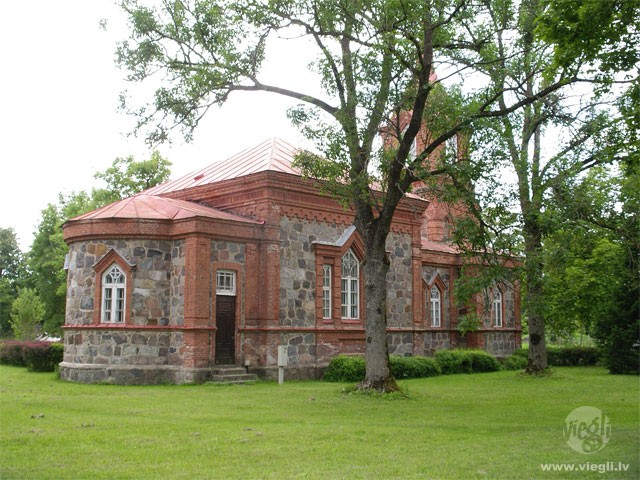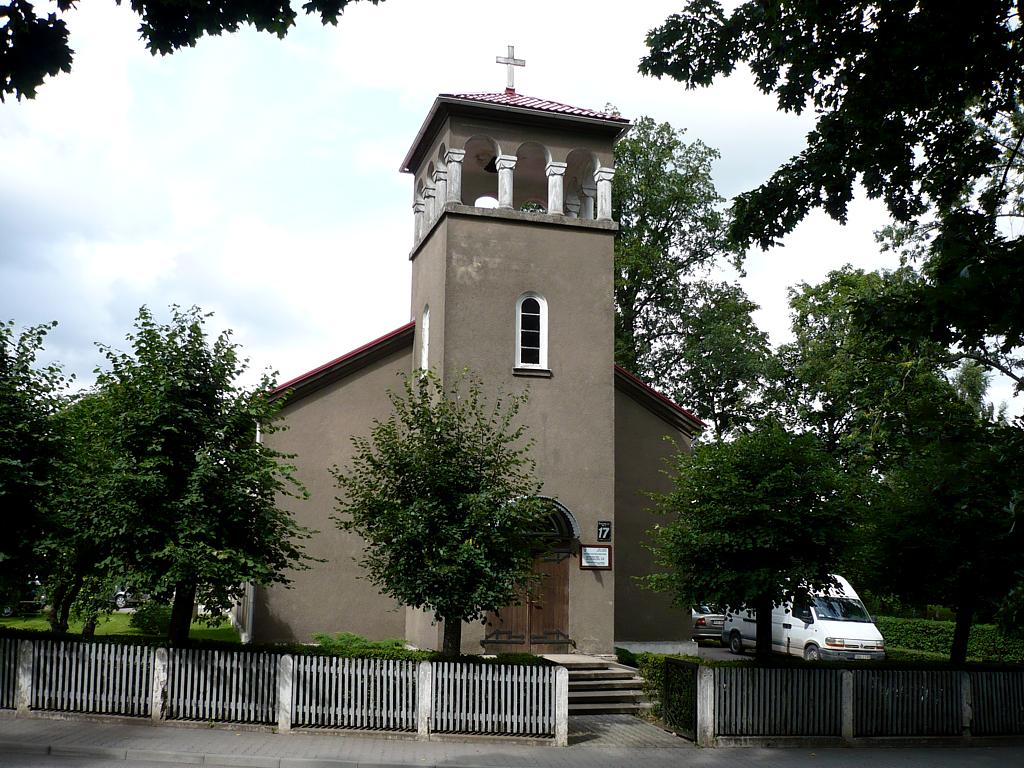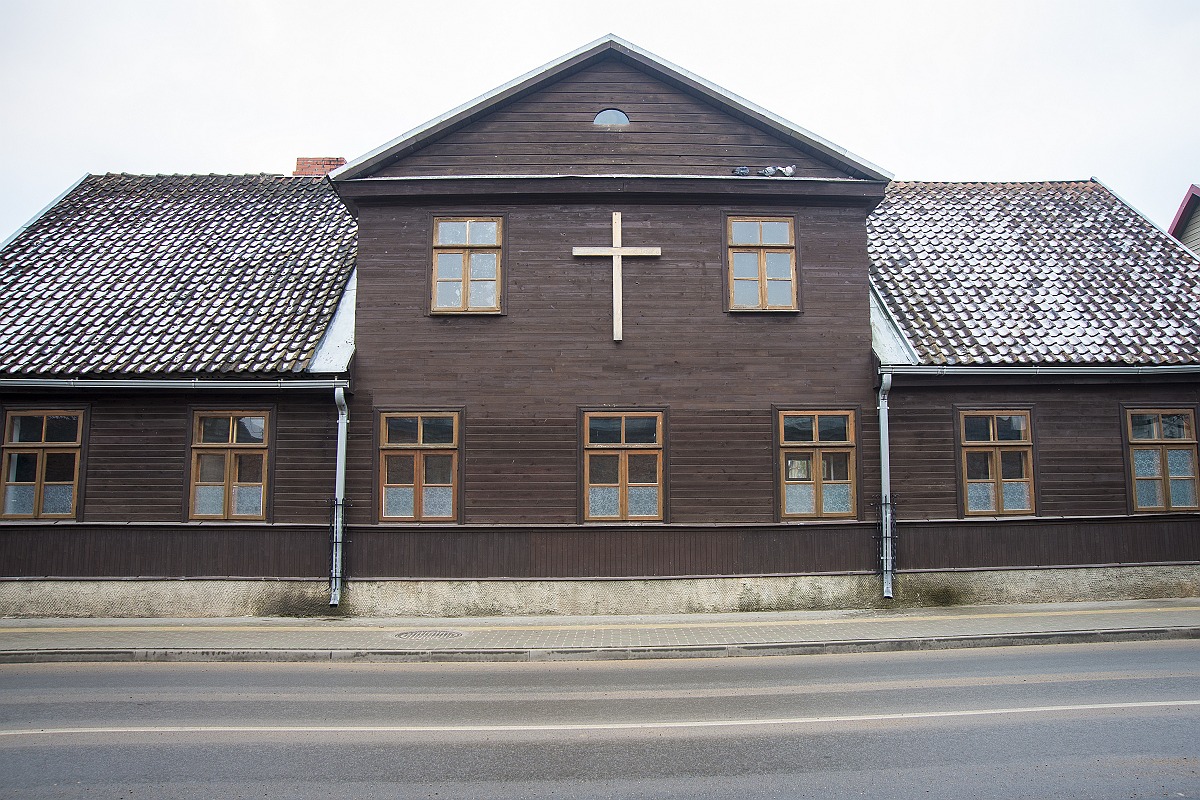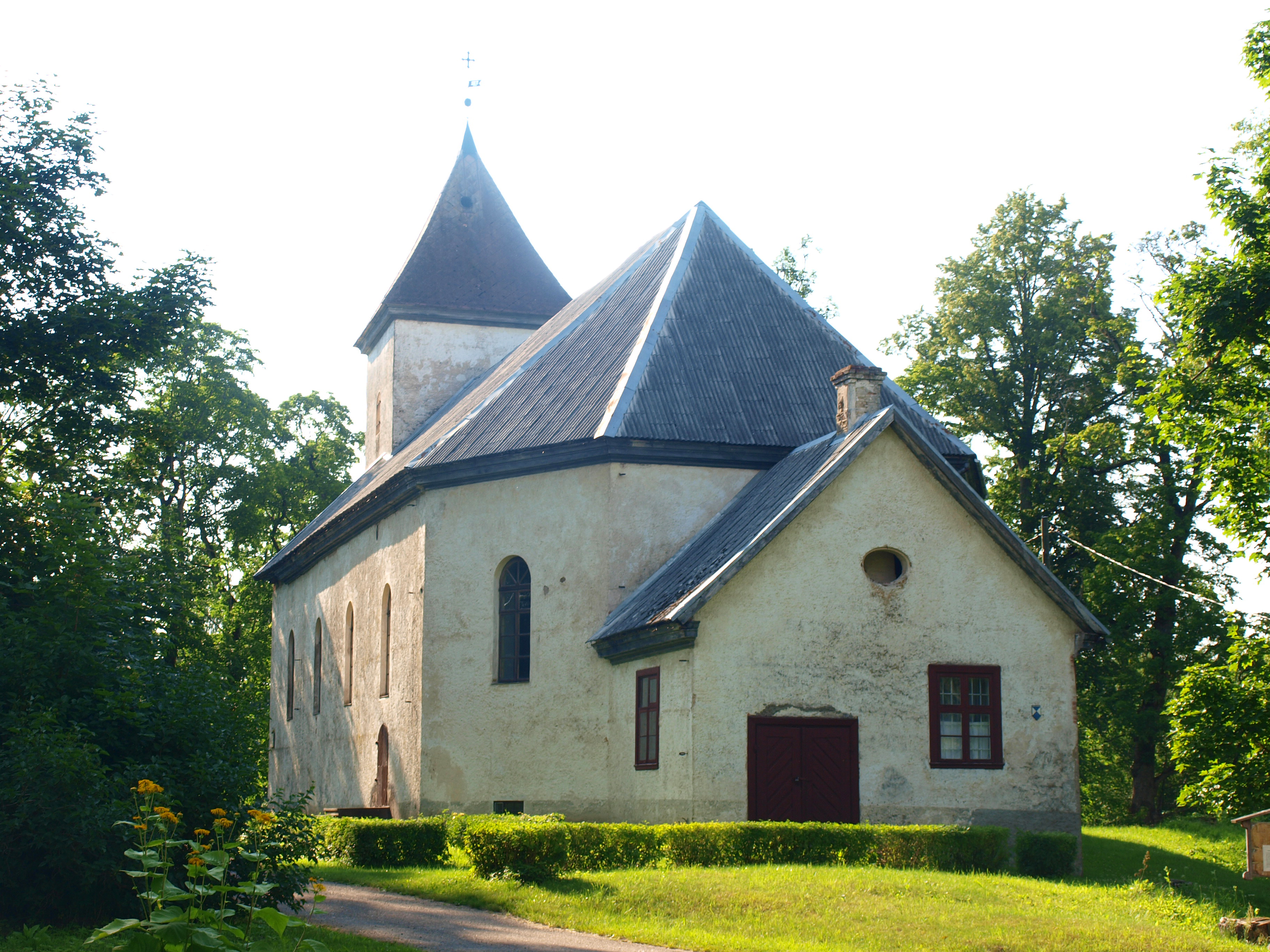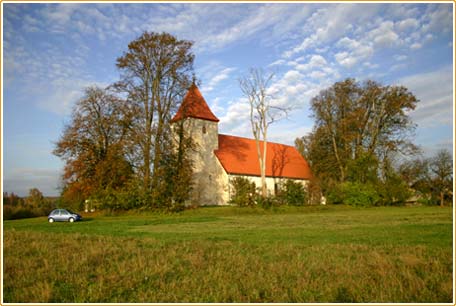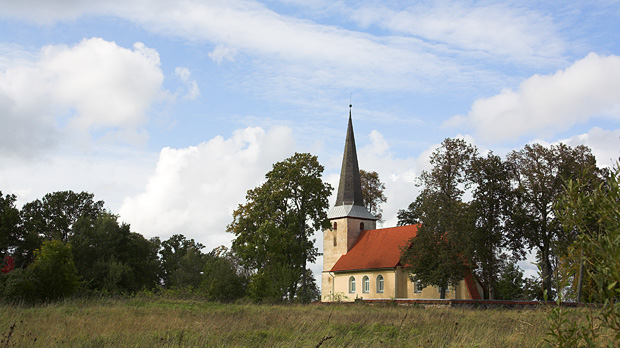Around Aizpute:
Church mound and Saint John’s church
 On the opposite side of Aizpute castle ruins, on the right side of the river Tebra is the 16 meters high Kurshi castle mount (now church mount). In the year 1254, in the place where German crusaders robbed and ruined the ancient Kurshi castle, a castle was built. The Saint John evangelic Lutheran church has been renovated and rebuilt and today it is one of the oldest churches in Courland. Up until 16th century Catholicism was preached, but after that it was given to the evangelic Lutheran congregation. In 1571 the first Lutheran priest Johanim Reming, who worked here for 43 years. The church has been rebuilt many times – the tower was built in 1730, the altar in the late 19th century, but it got it’s nowadays look in 1860. The bell of the church is also very noteworthy, which 400 years ago (in 1589) after re-casting started to ring again. There is an organ built by the famous German company “Sauer” in 1904, also there are paintings like “Kristus Ģetzemanes dārzā” (Christ in the garden of Gethsemane)(J.I. Egniks, 1833) and “Krustā sistais”(The one nailed to the cross)(J.F. Vāgners, 1864) and to the right from the altar you can see the gravestone of the bishop of CourlandH.Bazedovs. Aizpute Saint John Lutheric church is one of the oldest churches in Courland, it is a national architectural monument and it is included in the European cultural heritage list.
On the opposite side of Aizpute castle ruins, on the right side of the river Tebra is the 16 meters high Kurshi castle mount (now church mount). In the year 1254, in the place where German crusaders robbed and ruined the ancient Kurshi castle, a castle was built. The Saint John evangelic Lutheran church has been renovated and rebuilt and today it is one of the oldest churches in Courland. Up until 16th century Catholicism was preached, but after that it was given to the evangelic Lutheran congregation. In 1571 the first Lutheran priest Johanim Reming, who worked here for 43 years. The church has been rebuilt many times – the tower was built in 1730, the altar in the late 19th century, but it got it’s nowadays look in 1860. The bell of the church is also very noteworthy, which 400 years ago (in 1589) after re-casting started to ring again. There is an organ built by the famous German company “Sauer” in 1904, also there are paintings like “Kristus Ģetzemanes dārzā” (Christ in the garden of Gethsemane)(J.I. Egniks, 1833) and “Krustā sistais”(The one nailed to the cross)(J.F. Vāgners, 1864) and to the right from the altar you can see the gravestone of the bishop of CourlandH.Bazedovs. Aizpute Saint John Lutheric church is one of the oldest churches in Courland, it is a national architectural monument and it is included in the European cultural heritage list.
Address: Liepājas iela 3, Aizpute, (+371) 25907747, www.aizputesaeld.lv
Catholic Church
The first Catholic church in Aizpute was built in 1254. In 1580’s because of the historical events it was made into a Lutheran church. In 1732 a dean named J Genner from Jelgava bought a house in Aizpute, in which he made a chapel for Catholics. After about a hundred years, this building was about to collapse, that’s why a dean named Jāzeps Sandovičs from Ventspils signed an agreement with innkeeper Antonevich, which later was found out to be disadvantageous – the church leased land to the innkeeper for 53 years, in exchange the owner of the inn built a new chapel for the church. In 1935 dean J.Daugis got back his land that was loaned out on a contract basis together with the buildings that were on the land and started to think about building a new church. After the Second World War the Soviet authorities nationalised church properties, leaving only one old house which was located on the side of the road to the church, this house wasn’t suited to house a church. In 1955 with allowance from the Bishop the old wooden church in Gudenieki was torn down and transported to Aizpute. With the transported materials dean J.Snepsts rebuilt the old house in Kuldīgas street into a church in 1956, in the same year the house was blessed by the Liepāja diocese apostolic administrator Julians Vaivods as a church, dedicating it to the honour of King Christ. That turned out to be the only church built in the Soviet Era in Latvia. In 2002 15th November the foundation-stone was blessed and a special capsule was immured, in which there was a testimony about blessing the foundation-stone, coins, medallion and Rosary of Saint Benedict. Later in 2009 April 18th consecration of the new Aizpute church took place, which was executed by Liepaja diocese bishop Vilhelms Lapelis together with Ārvaldis Andrejs Brumanis and priests, devoting it to Ignatius of Loyola.
Address: Kuldīgas iela 2, Aizpute, (+371) 26578580, (+371) 63449990
Aizpute Seventh-day Adventist Church
The Adventist church acquired their meeting house in 1993. Before that, the church building hosted Aizpute Orthodox church parish. Address: Kalvenes iela 38a, Aizpute, (+371) 29720361
Aizpute Baptist Parish
Aizpute Baptist Parish was founded in 1869, its first priest, later also Latvian Baptist Parish bishop – Ādams Gertners, who was later kept in a prison in Aizpute and also Kuldīga.
First church building was built in 1884, but after 8 years in 1892, with the pretence, that the Baptist church is too close to the Orthodox Church building, the tsar administration demand to take down the church building.
In 1893 the Parish made the decision to buy a piece of land in Kuldigas iela 17, for 750 roubles. And in the same year a second church building is built. The parish used this building until 1937 march 21st, when on Passion Sunday the church burns down in a fire. Then it was decidet to start gathering materials for a new church building. The parish builds its third church building after the Baltic German’s Aleksandera Šmēlinga project in 11 months. In Christmas of 1939 it is blessed. The parish hasn’t stopped its actions neither during the 1st or 2nd World War. From 1949 till 1990 Aizpute Seventh-day Adventist parish also holds its public worships in these rooms, since the Soviet authority had taken away rooms to meet from them.
Address: Kuldīgas ielā 17, Aizpute, (+371) 26336783
Aizpute Pentacostal Church
Aizpute Pentacostal Church is registrated in 1989. Until then, in the Soviet times, the parish operated in the parishes founder’s and first priests self-built house. In the same year the parish bought a house on Kalvenes street 12, which was rebuilt into a church and already in 9th December of 1990 the church unveiling service took place. In 2000 the parish bought a building in Kalvenes iela 10 in which a bigger hall was constructed for the parishes services. Address: Kalvenes iela 12, Aizpute
Around Cīrava:
Cīrava Lutheran Church
Cīrava Lutheran Church was built in baron H.F. Von Bera time from 1780 till 1781un Sudmalkalns (a hill). From the outside it was similar to other churches of Kurzeme with its pyramid shaped tower, red tile roof and massive brick walls. The altar and pulpit is a rococo style piece of art(author is unknown). The altar, pulpit and kungu sols, which supported on a woman’s head, as well as the gallery of the organ and the decorative finish of the rooms is a national art monument. There is also an old church bell and organ from the 18th centuries beginning. There is a portrait of baroness Juliana Elizabete von Bera in white marble. Many valuable interior objects have survived – candlesticks, confessional, offering vessel, a goblet and a paten. In the crypt under the church lies Aizpute manor house lady J.E. von Bilova and her daughter J.E. von Bera. Both of the luxurious sarcophagus are now found in Rundāles castle museum.
Contactperson: Līga Grīnvalde
Phone: +371 26401508.
If arranged beforehand, there is a possibility to hear and enjoy the churches organ sound.
Around Kazdanga:
Valtaiķi Church
Valtaiķi church is 5 kilometres away from Kazdanga castle and even if nowadays territorially it is in Kuldīga County, it is very connected with Kazdanga. As soon as in 1792 a stone church was built, from the outside it was very simple and similar to other churches in Courland. The church of Valtaiķi is outstanding because of its beautiful and detailed stained glass, which were ordered from Italy by baron von Manteifelis in 20th century after sketches made by Vilhelms Purvītis. There are four stained glass windows around the altar, which tell a story about warrior’s three manners – bravery, godliness, compassion and charity. The other stained glass windows depict events from the New Testament. In the bottom part of the windows there are Manteifeļi and their wife emblem which depict the family’s history.
Address: Valtaiķi, Laidu pagasts, Kuldīgas novads
Phone: (+371) 25425466
To visit the church, please arrange the visit beforehand over the phone.
Around Apriķi:
Apriķi Lutheran Church
Apriķi church is considered to be the pearl of Courland sacral art, because the glory of its indoor interior is remembered by its every visitor. The stone church is built on Apriķi manor house land as Osten-Sakenu private church in the beginning of 17th century. The church got its glorious blue-white and golden coloured interior in the middle of the 18th century. The main influence in the interior is rococo, but specific elements share distinct baroque characteristics.
The pulpit, organ gallery, organ, altar, confessional make up a unified ensemble – decorative wood-carving masterpiece. The interior of the church is made even more luxurious by its ceiling, where there is a depiction of the sky and allegoric beings (truth, caution, hope etc.) and over the organ gallery there is a whole orchestra of angels depicted.
Address: Apriķi
Phone: (+371)26658606 – Inese Vīdnere
Entrance in exchange for donations.
Surrounding
Klostere (Jāmaiķi) church
Klostere St. Peter church once belonged to the church of Aizpute. In 1591 in church archives is written that Aizpute parish has a small church near Piltene, but belongs to Aizpute. The small wooden church has been located on a hillside near Jāmaiķi manor and where the roads were crossing. In 1792 was built stone tower, which is still visible today, but in spring of 1862 with help from Kazdanga Baron Karl von Manteifels the church has been renovated. In October 1902, the church was unusable and it was closed. Now the church is restored and are organising religious services on a regular basis.
Address: Jāmaiķi, Turlavas pag., Kuldīgas nov., (+371) 26462824
